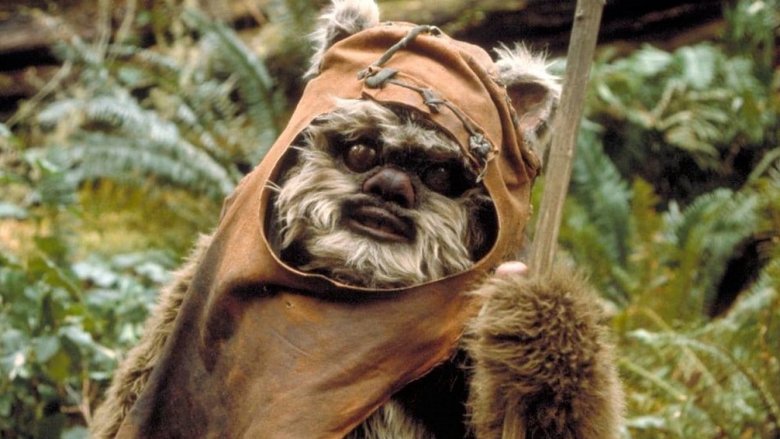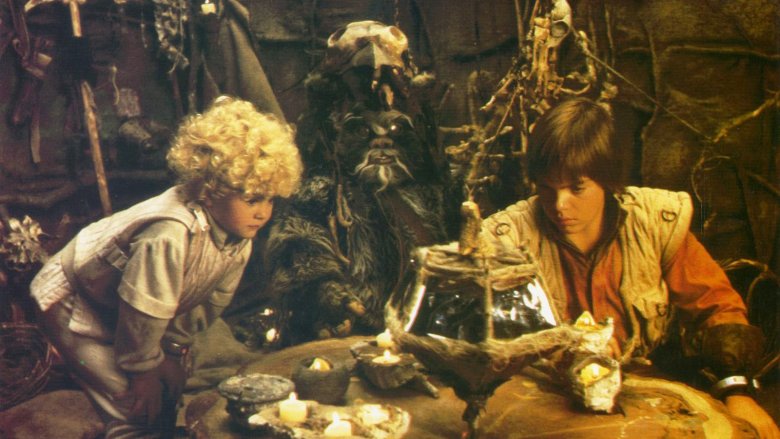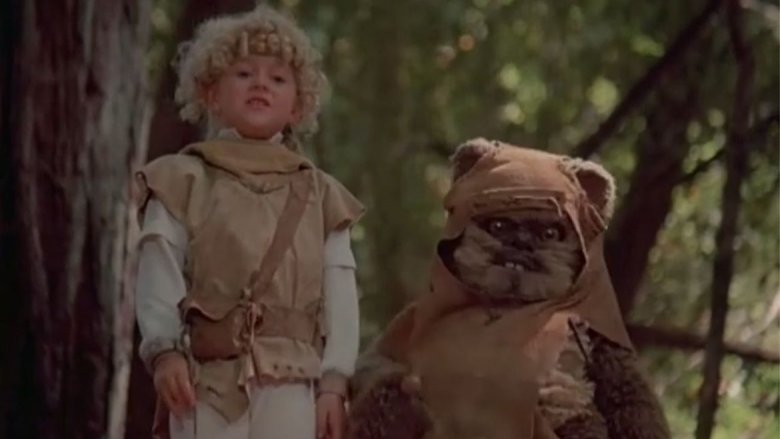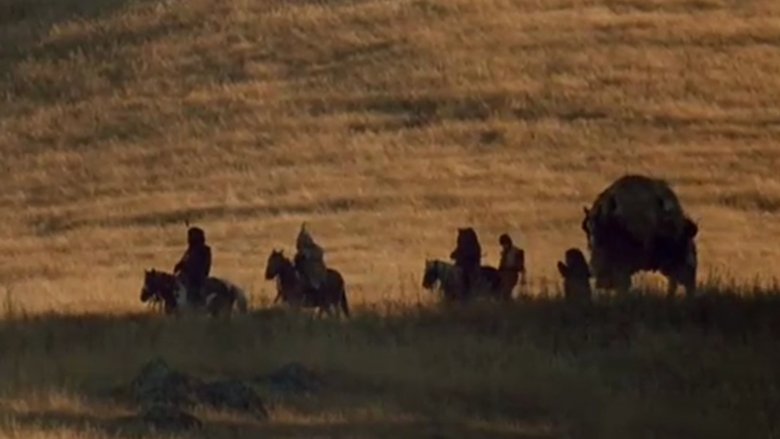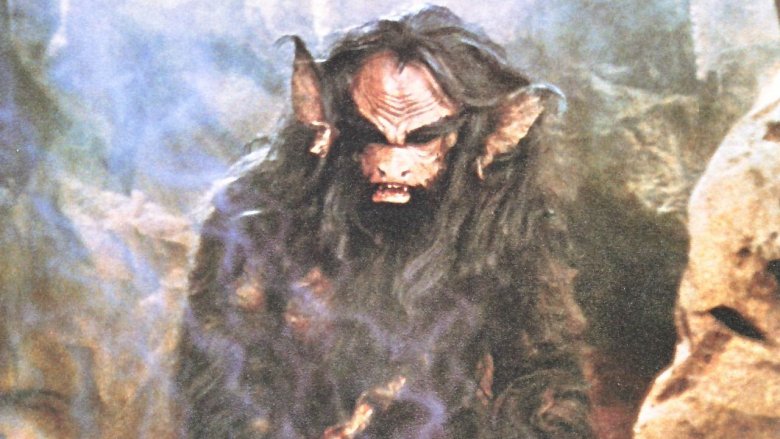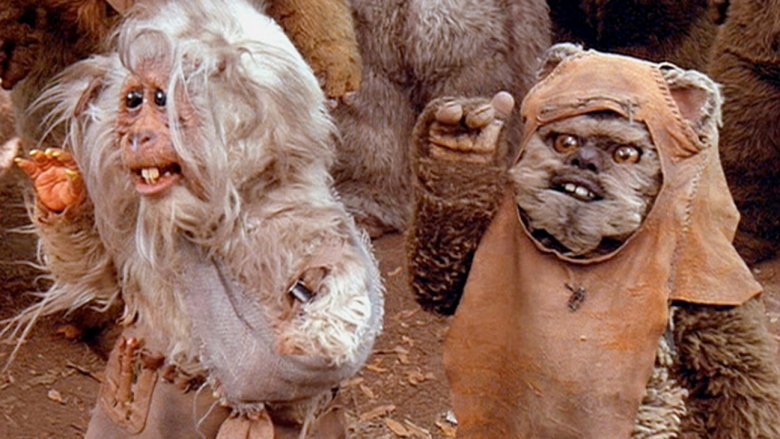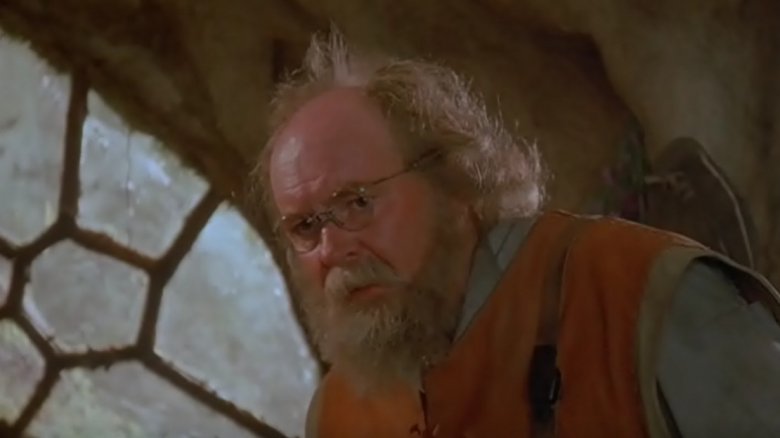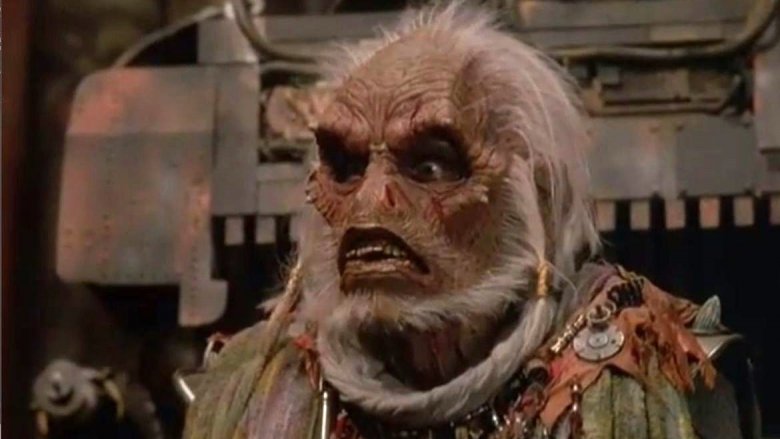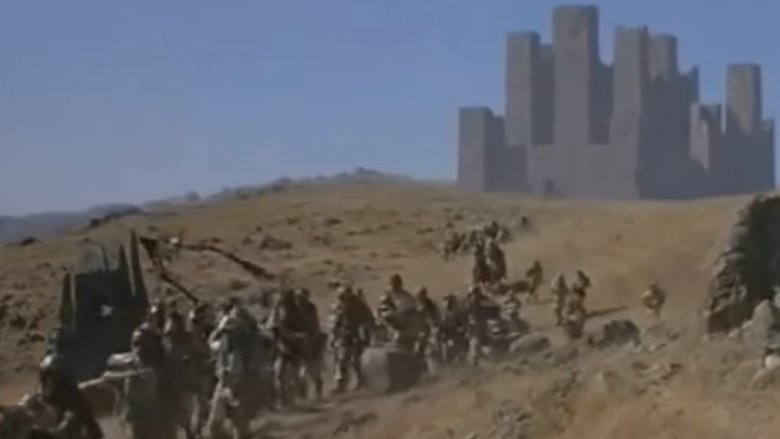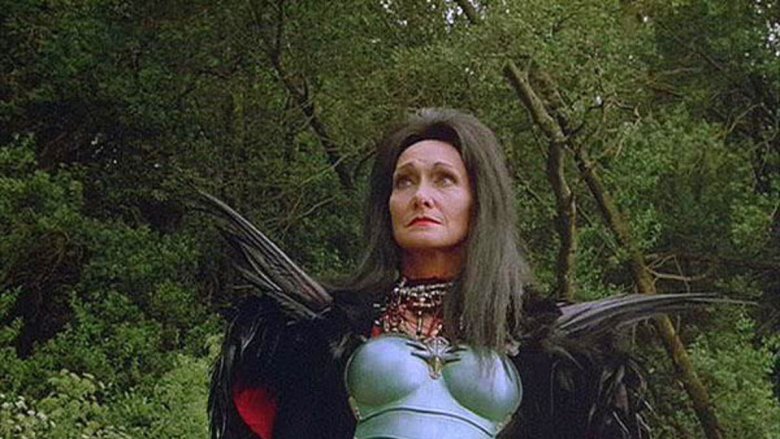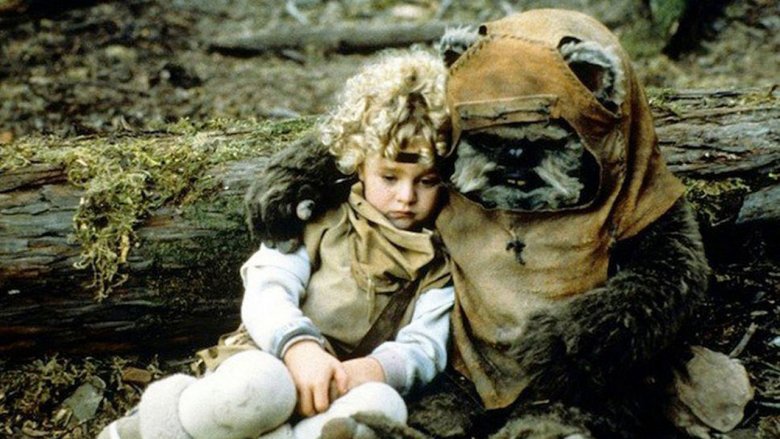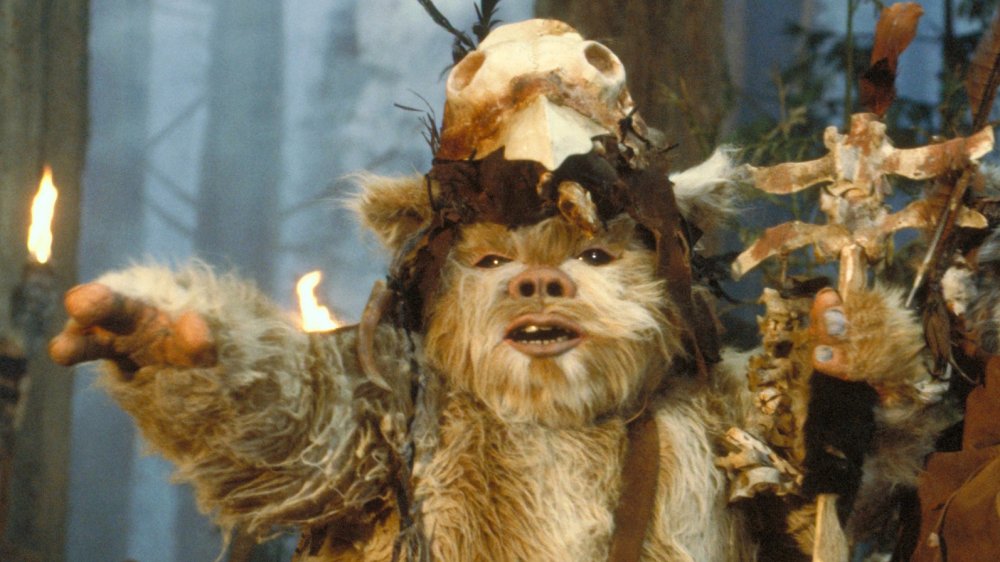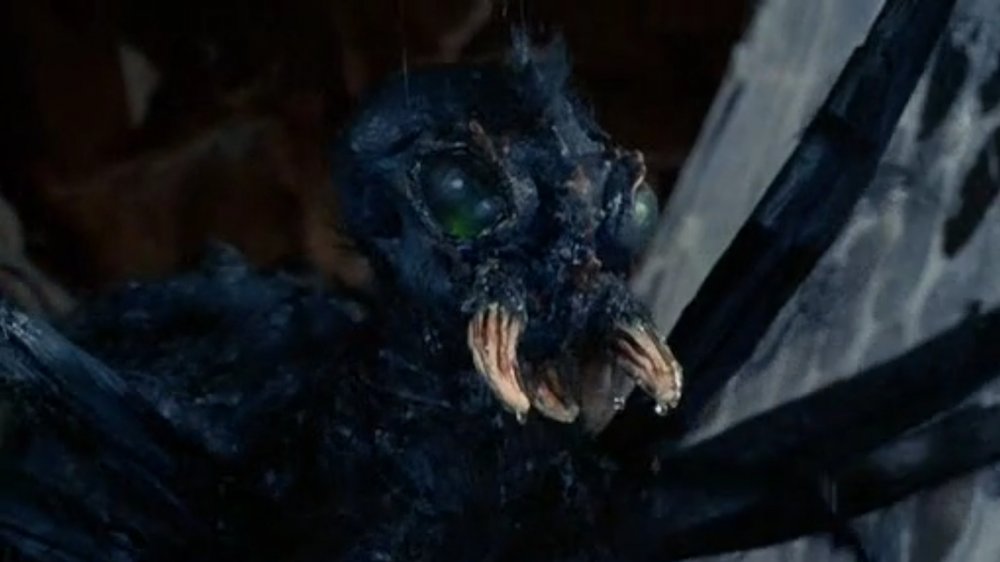The Star Wars Ewok Adventures Explained
In 1984, after the success of Return of the Jedi and the end of the original Star Wars trilogy, George Lucas set out to develop some kind of continuation of the galaxy he'd created in the form of a new TV special. With help from key collaborators, that idea ultimately grew into two TV movies released over the course of two years that, while often overlooked now, remain fascinating installments in the overall Star Wars franchise. It's time to talk about The Ewok Adventures.
Between Caravan of Courage in 1984 and The Battle for Endor in 1985, Lucasfilm transformed the forest moon only present in a few key sequences in Return of the Jedi into a rich fantasy landscape full of strange creatures, new threats, and more than a little magic. Now, decades after Caravan of Courage premiered, we're taking a look back at these little touchstones from a time when Star Wars was looking for a new way forward... and things got a little bit weird. These are the Star Wars Ewok Adventures explained.
Origins
In 1983, as far as much of the general public was concerned, Star Wars ended its story with Return of the Jedi, the third film in the original trilogy which saw the defeat of Darth Vader and the Emperor and the triumph of the Rebel Alliance. Though George Lucas' prequel films wouldn't actually come along for more than a decade, Lucas was far from done with his galaxy, and wanted to continue telling Star Wars stories in some form. This started with Ewoks, the furry creatures from Return of the Jedi, and what was initially going to be an Ewok Holiday Special that would air on television. As discussions about the Ewok story went on, the story expanded to feature length, and the name was changed to The Ewok Adventure to avoid associations with the infamous Star Wars Holiday Special from 1978. Now known as Caravan of Courage: An Ewok Adventure, the first film was shot on location in the California Redwood forests near Skywalker Ranch, and premiered on ABC in November of 1984.
The timeline
At the time the first Ewok Adventure was conceived, the teddy bear-like creatures were only known for their appearance in Return of the Jedi, and Lucas and company wanted to keep the story relatively standalone. As a result, the first film contains few of the hallmarks we associate with Star Wars. The Ewoks themselves, and their forest moon home on Endor, are just as we remember them from Jedi, but apart from things like the orange flight suit the character Mace Towani (Eric Walker) wears, the use of a blaster (which Mace only calls a "gun") and the involvement of a starcruiser in the plot, there's not much to make the film look like Star Wars.
This sense of separation from the main Star Wars saga begs the question of when exactly the films are set, and there was initially a little bit of disagreement on that front. In a retrospective interview with Empire, Walker recalled that the original plan was to set the films decades after Return of the Jedi, sometime in the far future of the saga, with the explanation that Ewoks have long lifespans and therefore the Ewok hero Wicket (Warwick Davis) could still be around. Later, though, Lucasfilm placed the two Ewok Adventures on the timeline between the events of The Empire Strikes Back and Return of the Jedi, which means Wicket and his friends were dealing with humans well before Princess Leia showed up.
A quest begins
Caravan of Courage, the first Ewok Adventure, is the story of Cindel (Aubree Miller) and Mace Towani, siblings who find themselves stranded on Endor after their family starship crashes and their parents are abducted by a giant monster called the Gorax. We know the creature's name, as well as the names of the Ewoks, because the entire affair is narrated by none other than legendary singer and actor Burl Ives. Ives' cool, calm voice gives many of the Ewok-only sequences the feel of a nature documentary.
Though Mace is initially hostile toward the Ewoks in part because he can't understand them, Cindel and Wicket become friends, and the Ewoks help Cindel find medicine when she becomes sick. It's here that magic first enters the picture, as the Ewoks take Cindel and Wicket to the mystical Ewok Logray, who shows them their parents in captivity at the fortress of the Gorax. Now aware of how to get their parents back, Mace and Cindel beg the Ewoks for help, and a select few are chosen to travel to the Gorax's mountainous home to stage a rescue with the help of some magical artifacts offered up by Logray. There's a very Fellowship of the Ring vibe to the whole thing as the Ewoks set out for a grand adventure that enhances the scope of what Endor has to offer the Star Wars galaxy.
A battle with a monster
The fantasy tropes and Tolkienesque feel only deepen as Caravan of Courage heads into its third act, and our adventurers discover everything from a wayfinding arrowhead hidden in a rock gifted to Mace by Logray to giant spiders patrolling a massive web inside the Gorax's cave. When they eventually do reach the lair of the Gorax, Mace finds his parents in a giant wooden cage, and with the help of the Ewoks manages to free them. While fleeing The Gorax — a giant, hairy creature that would have wreaked havoc on the Empire's shield generator in Return of the Jedi — the Ewok Chukha-Trok dies when rocks fall on him during the Gorax's pursuit. Together with the humans, the Ewoks manage to kill the Gorax by causing it to fall into a pit, and Mace using Chukha-Trok's axe to deal the final blow as revenge for his fallen friend. Though there are hints of Star Wars here, the whole thing plays out much more like a fantasy adventure, and if you'd never seen a Star Wars film before this one you'd barely think it involves things like space battles or the Force at all.
Success leads to a sequel
Caravan of Courage proved to be a massive success, garnering 65 million viewers (many of whom recorded the event with their then-new VCRs) and two Emmy nominations and setting the stage for a sequel. Lucas launched into story sessions with production designer Joe Johnston and visual effects wizard Phil Tippett (both of whom would go on to great success as Lucas proteges) and brought in sibling directors Jim and Ken Wheat to helm the next film and tackle the screenplay.
At the request of his daughter, who was saddened by Chukha-Trok's death, Lucas left out any Ewok fatalities in the second film, but everything else was wide open. Together, the creative team hashed out an even bigger fantasy saga that introduced a number of new threats and characters into Ewok lore. The result was Ewoks: The Battle for Endor, which aired on ABC almost a year to the day after the first film in November 1985.
An orphan looks for help
The Battle for Endor opens just as the Towani family are preparing to depart Endor in their newly repaired starship — an escape that quickly becomes a bloodbath. A group of Sanyassan Marauders led by the evil Terak (Carel Struycken) and his shapeshifting witch sidekick Charal (Sian Phillips) storms the ship, murdering the entire family save for Cindel, who escapes into the woods with Wicket. Wicket, who's learned to speak broken English at this point, decides to keep Cindel safe no matter what.
While wandering in the forest, Cindel and Wicket meet a super-fast rabbit-like creature named Teek, who shows them to the hut of Noa (Wilford Brimley, who was apparently a handful to work with), a hermit who crash-landed on Endor years earlier and had no choice but to stay when he couldn't repair his own ship. Noa is initially angry to see strangers, even though one of them is a helpless child, but he ultimately agrees to look after Cindel and Wicket when they insist they have no place to go.
Meanwhile, at the castle of the Marauders (apparently this planet is just peppered with fortresses of all kinds), Charal tries to unlock the "power" of the fuel cell from the Towani family spaceship, because Terak is convinced that it's magic and wants to exploit it for himself. When Charal can't do what he wants, Terak orders her to find Cindel, believing she will have the key to "the power."
The Ewoks vs. an army... again
Charal uses her magic ring, which allows her to change shape to turn into a beautiful woman and lure Cindel into a trap, then takes her back to Terak, who demands Cindel give him "the power." When Cindel reveals she doesn't know how to do anything with the fuel cell, he throws Cindel in jail along with Charal, taking her ring. Meanwhile, Noa, Wicket, and Teek begin to plan a rescue mission. They infiltrate the Marauders' castle, free Cindel, and take the fuel cell in the hope that it can power up Noa's own starship.
Enraged, Terak frees Charal (forcing her to turn into her raven form first) and launches a full-scale attack on the Ewok village, and the creatures defend themselves much as they do in Return of the Jedi, using things like rolling logs as traps. As the Marauders keep coming, Noa powers up his ship, but Terak recaptures Cindel. Noa demands a duel with Terak with Cindel's life on the line, and as they fight, Wicket uses his sling to hit the magic ring around Terak's neck. With the ring destroyed, Terak turns to ash, and Charal is left in bird form forever with no ring to change her back.
With the Marauders defeated, Cindel says goodbye to Wicket and leaves Endor onboard Noah's starship.
Strange implications
As we've already discussed, the Ewok Adventures films are only loosely connected to the rest of the Star Wars universe, which explains the initial idea that they'd be set 100 years or so after the events of the main saga to avoid any confusion. The ultimate decision to set them between Star Wars Episode V and VI, however, creates a number of interesting implications that the films never take the time to explore.
The most obvious of these is that, by the time of The Battle for Endor, Wicket speaks English frequently with Cindel. In the film itself this is simply to cut out the need for a narrator the second time around, but if you think about it in a larger context, it makes you wonder why he never broke that skill out when he met Princess Leia a short while later. Did he just forget?
Even more broadly, why are the Ewoks so friendly with Cindel and Mace, but so hostile to Luke, Han, and Chewbacca when they meet them? Are they just spooked by the weapons? Did the run-in with the Marauders make them nervous?
Then, of course, there's the question of how Endor as a place with its own ecosystem and several different kinds of civilized and semi-civilized life react when the Empire showed up to build a shield generator. It seems we'll never know, but it's wild to watch these films with that greater context in mind.
An expanded universe
Throughout the 1980s and 1990s the Star Wars world went on without additional films, and in place of more movie adventures we got what became known as the Expanded Universe, a wide-ranging series of stories in the form of video games, novels, comic books, and more. The EU introduced thousands of characters, planets, and concepts to the Star Wars galaxy in a sometimes messy way, so it's sometimes hard to chart all the connections. If you're looking for them, though, you'll see that the Ewok Adventures live on in some surprising ways.
For example, Cindel Towani makes a cameo appearance in the novel Tyrant's Test, the third book in Michael P. Kube-McDowell's Black Fleet Crisis Trilogy, in which it's revealed that she grew up to be a journalist on the Republic capital world of Coruscant. In 2019, Lucasfilm Story Group executive Pablo Hidalgo also explained the EU's connection to Charal, who was ultimately revealed to be a Nightisister from the planet Dathomir. These are the only major connections the rest of the EU had to the Ewok Adventures films, though further connections could someday be possible.
Are they canonical?
We've covered the plot, setting, and interconnected mythology of the Ewok Adventures films, and now we arrive at the question of their present relevance. Are the Ewok Adventures considered canonical?
The short answer is no, which explains why we haven't seen a Blu-ray release yet, though the longer answer is that for a long time the films were considered a canonical part of the Expanded Universe along with countless other stories that formed a mammoth Star Wars timeline. That all changed in 2014 when, after Disney purchased the company and launched new plans for the franchise, Lucasfilm revealed that the Expanded Universe as we knew it would draw to a close, and that most of the stories generated during the EU era would now be reframed as "Star Wars Legends," meaning stories that existed outside of the canonically accepted saga.
This announcement meant that all stories previously produced, other than six core Star Wars films and The Clone Wars animated series, were rendered non-canonical, though that didn't rule out future use of old EU characters and concepts in new, canonical stories. That means that while the Ewok Adventures films aren't canon anymore, there's always a chance someone could decide to throw something like the Gorax into a new tale.
Ewok Magic
When they first appear in Return of the Jedi, the Ewoks are depicted as a relatively simple tree-dwelling people who've clearly defined a culture for themselves, though that culture feels rather primitive. When it comes to their supernatural beliefs or religion, we know that they seem to worship C-3PO as a god upon seeing him, which suggests some kind of belief in a deity, but that's all the film really takes the time to give us.
The Ewok movies, then, presented a really interesting opportunity to expand on the various supernatural beliefs the title creatures may or may not possess. Caravan of Courage in particular decided to take advantage of that opportunity, and revealed new layers of the Ewok culture through the use of magic. The Ewok shaman Logray in particular seemed to have a real command of the magical arts, and before the Caravan set out on its quest, he offered the Ewoks and their friends a series of sacred tokens tied to Ewok warrior legends. These tokens include a magic crystal with hypnotic powers, a magic candle that seems to summon light fairy creatures, a walking stick that can pass through magical barriers, and a rock which hides a magical arrowhead that points the way forward for the group. The film never has time to expand on where these artifacts came from or how they work, but they all suggest a much deeper Ewok culture lurking beneath the surface of the films.
Danger on Endor
The Star Wars heroes of the original trilogy spend a lot of time on Endor in Return of the Jedi, and over the course of that film we get the impression that it would be a relatively peaceful planet if not for the Empire. The Ewoks clearly have weapons and know how to fight, but most of their weapons look more like what you'd use for hunting than war, and outside of Imperial interference they seem to have a pretty quiet life in the trees. With the Empire out of the picture for the Ewok movies, Lucasfilm had to come up with other threats for the characters to fight, and that's when it becomes clear that Endor is actually a pretty terrifying place to live.
Even setting aside the main antagonists of each film — the Gorax in Caravan of Courage and the Marauders in The Battle for Endor — there are a lot of terrifying, deadly creatures to contend with on the forest moon. in Caravan of Courage alone, the Ewoks and their human friends must contend with a massive beast called a boar-wolf, the tree-dwelling trapper known as a Temptor, and most memorably, gigantic spiders that dwell in a massive web inside the Gorax's mountain fortress. No wonder the Ewoks are so good with spears and slings.
